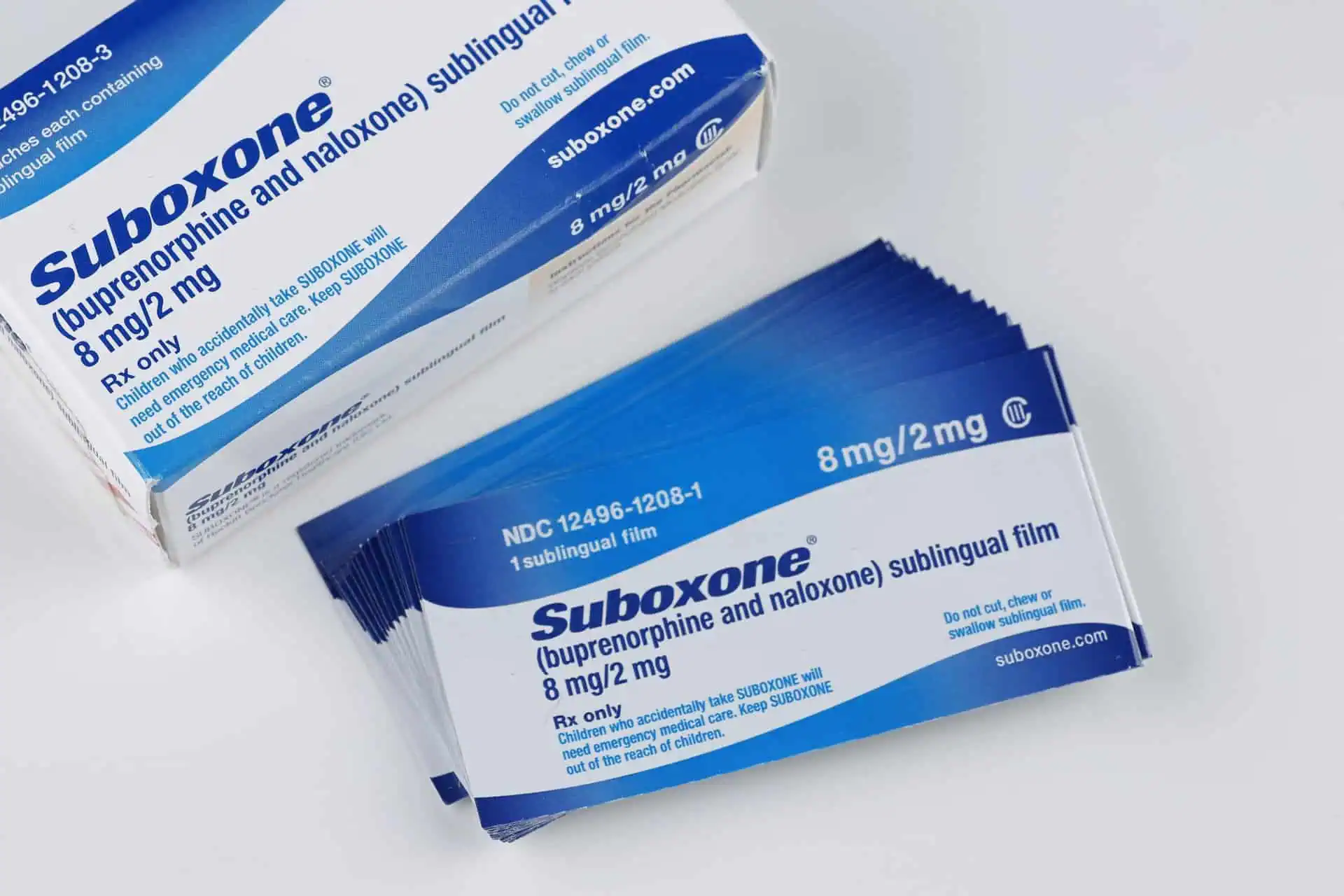The Suboxone Tooth Decay MDL
- Last Updated: June 12th, 2025

Attorney Jessica Paluch-Hoerman, founder of TruLaw, has over 28 years of experience as a personal injury and mass tort attorney, and previously worked as an international tax attorney at Deloitte. Jessie collaborates with attorneys nationwide — enabling her to share reliable, up-to-date legal information with our readers.
Legally Reviewed
This article has been written and reviewed for legal accuracy and clarity by the team of writers and legal experts at TruLaw and is as accurate as possible. This content should not be taken as legal advice from an attorney. If you would like to learn more about our owner and experienced injury lawyer, Jessie Paluch, you can do so here.
Fact-Checked
TruLaw does everything possible to make sure the information in this article is up to date and accurate. If you need specific legal advice about your case, contact us by using the chat on the bottom of this page. This article should not be taken as advice from an attorney.
Overview of the Suboxone Tooth Decay MDL [2025 Complete Guide]
On this page, we’ll discuss an overview of the Suboxone Tooth Decay MDL, impact of Suboxone sublingual strips on dental health, psychological side effects of Suboxone, and much more.
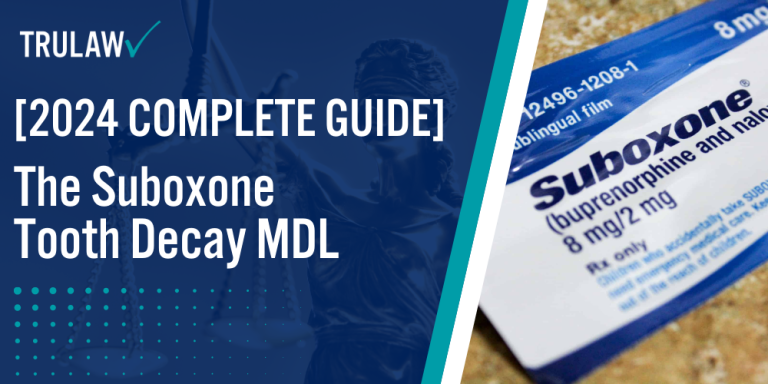
Intro to the Suboxone Tooth Decay MDL
The Suboxone Tooth Decay MDL has been established in the Northern District of Ohio under MDL No. 3092 as the number of personal injury and product liability claims reaches over 100 claims as of July, 2025.
The claims made against Indivior (Suboxone’s manufacturer) focus on the following allegations:
- Product Design Deficiencies: Claims assert that Suboxone’s sublingual film is inherently flawed, causing dental decay due to its acidic properties.
- Insufficient Dental Risk Warnings: Indivior is accused of failing to adequately warn users about the potential for dental harm from Suboxone films.
- Safety Testing Negligence: Allegations of inadequate research into Suboxone’s dental health impacts, suggesting overlooked oral health risks.
- Safety Misrepresentation: Indivior allegedly minimized the dental risks of Suboxone films, misleadingly suggesting it was safer for oral health than it is.
If you or a loved one has experienced dental issues after taking Suboxone, you may be eligible to join the ongoing Suboxone Tooth Decay MDL.
Contact TruLaw using the chat on this page for an instant case evaluation from a licensed Suboxone Tooth Decay Attorney.
Table of Contents
Risks Associated With Long-Term Sublingual Suboxone Usage
A scientific study led by Mahyar Etminan, titled “Association Between Sublingual Buprenorphine-Naloxone Exposure and Dental Disease,” investigates the risk of long-term usage of sublingual buprenorphine-naloxone.
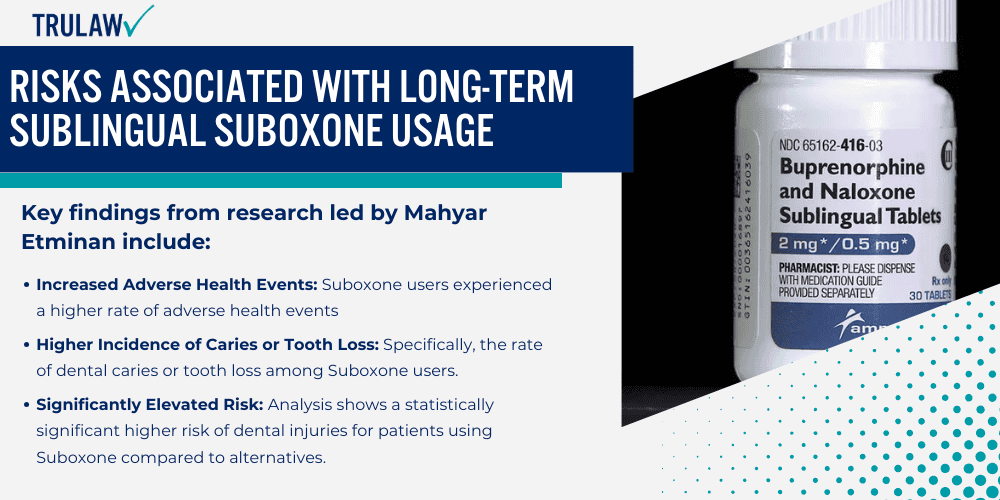
The findings published in the Journal of the American Medical Association (JAMA) suggest a notable correlation between the use of sublingual buprenorphine-naloxone (Suboxone) and an increased frequency of dental issues compared to other opioid addiction treatment methods.
The actions taken by Indivior to launch a generic version of its Suboxone sublingual film “at-risk” in collaboration with a subsidiary of Novartis displays a strategic approach to preserve a multi-billion dollar annual market share.
Negative Dental Health Effects: Suboxone Sublingual Strips
The analysis utilized data from the PharMetrics database, encompassing patient records from 2006 to 2020, to create a cohort of new users to treat opioid addiction.
Key findings from the research led by Mahyar Etminan include:
- Increased Dental Adverse Events: Sublingual buprenorphine-naloxone users saw a higher rate of dental adverse events, 21.6 per 1000 person-years, versus 12.2 for transdermal buprenorphine medications and 10.9 for oral naltrexone users per 1000 person-years.
- Higher Incidence of Caries or Tooth Loss: Specifically, the rate for dental caries or tooth loss was 8.2 per 1000 person-years among sublingual buprenorphine-naloxone users, compared to 3.5 and 3.8 per 1000 person-years for transdermal buprenorphine and oral naltrexone users, respectively.
- Significantly Elevated Risk: Adjusted analyses showed a statistically significant higher risk of severe dental injuries for patients using Suboxone compared to alternatives.
The study uncovers a notable concern that the acidic properties of sublingual buprenorphine-naloxone, combined with its application under the tongue, could potentially lead to dental damage.
This research highlights the importance of including dental health within the comprehensive care plan for patients undergoing treatment with sublingual buprenorphine-naloxone (Suboxone) for opioid addiction.
Patient Testimonials: The Symptoms of Suboxone Side Effects
The personal stories of individuals struggling with dental complications from Suboxone use shed light on the real-world impact that extends beyond the data.
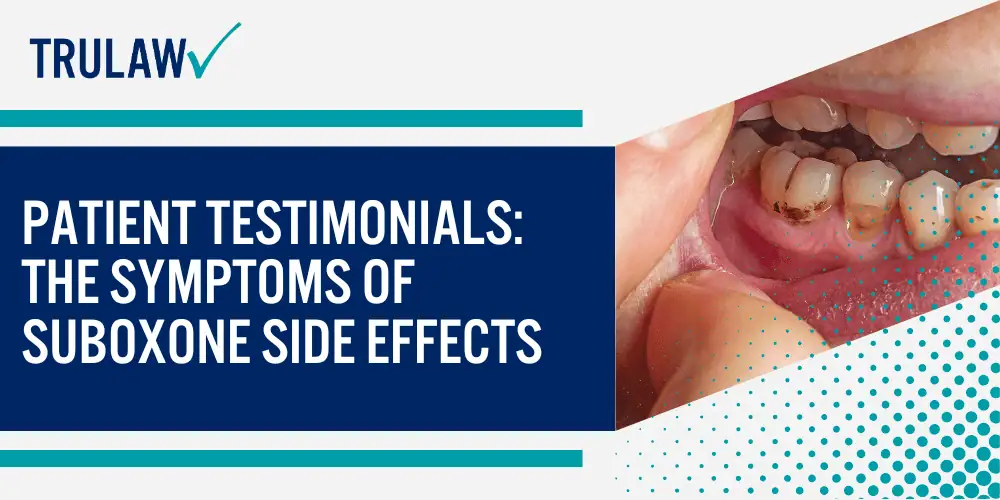
These direct accounts highlight the importance of raising awareness, providing support, and ensuring responsibility regarding the side effects of Suboxone.
Unveiling Hidden Dental Health Risks of Suboxone Treatments
While Suboxone has been celebrated as a medication prescribed for opioid addiction treatment, it has become known to be an impactful force in the treatment of opioid-related dependencies.
Nevertheless, recent investigations have uncovered an elevated incidence of dental complications in patients receiving Suboxone therapy.
Commonly reported symptoms of Suboxone’s side effects include:
- Dry Mouth (Xerostomia): Suboxone users frequently report symptoms of dry mouth, a condition that significantly reduces saliva production. Saliva is crucial for neutralizing acids in the mouth and preventing tooth decay, making its reduction a risk factor for dental health.
- Gum Disease: There is an observed association between Suboxone use and the development of gum disease or gingivitis, which can lead to more severe periodontal issues if left untreated.
- Enamel Erosion: Suboxone’s acidity, particularly when administered sublingually, can lead to enamel erosion. This weakens teeth and makes them more susceptible to cavities and decay.
- Increased Risk of Dental Caries: Patients using Suboxone in sublingual or buccal form have been reported to experience a higher incidence of dental caries and tooth loss than those on other forms of medication, such as transdermal buprenorphine or oral naltrexone.
From the Community: Suboxone Stories
The Suboxone Tooth Decay MDL has brought forward hundreds of adverse health reports revealing a pattern of insufficient warning about the risk of severe dental decay.
As these individuals band together, their collective narratives not only seek justice but also aim to spark systemic change, advocating for better patient education and safer medication practices.
The MDL documentation, such as the Transfer Order for the Suboxone (Buprenorphine/Naloxone) Film Products Liability Litigation, details the formal recognition of these shared experiences and the legal avenues being pursued to hold Indivior accountable.
This formal recognition within the judicial system affirms the collective struggle and legal battle faced by those impacted by Suboxone’s dental side effects, setting a precedent for collective action in pharmaceutical litigation.
Through these stories, the impact of Suboxone on dental health becomes vividly clear, moving beyond abstract legal and medical discussions to the very heart of the human experience.
TruLaw stands with you.
By sharing your story, you join a powerful movement toward change, ensuring future patients receive the full picture of their treatment options.
Case Studies on Suboxone Litigation
The Suboxone Tooth Decay MDL is marked by numerous individuals coming forward with their experiences of dental health issues attributed to Suboxone use.

The legal landscape surrounding Suboxone-related dental decay is characterized by a growing number of individuals stepping forward to share their experiences of oral health deterioration linked to the medication.
Impact Stories From The Suboxone Tooth Decay MDL
The adverse dental outcomes associated with Suboxone, as evidenced in legal proceedings and personal narratives, paint a stark picture of the medication’s potential impact.
These stories elaborate and humanize the struggles faced by those receiving Suboxone treatment.
Here are a few first-hand case studies on Suboxone that increase the urgency for legal and medical scrutiny of opioid-related treatments:
- David Sorensen’s Fight for Justice: In a landmark case filed in September 2023, David Sorensen took legal action against Indivior, the maker of Suboxone, after suffering extensive dental damage that required significant treatment. His story highlights the prescription drug and manufacturer’s alleged failure to adequately warn users and medical professionals about the risks of dental decay and tooth loss associated with prescribed suboxone use.
- The Collective Voice of MDL Participants: The consolidation of Suboxone tooth decay claims into a Multidistrict Litigation (MDL) in the Northern District of Ohio connects the shared experiences of numerous individual product liability claims for damages caused as a result of receiving Suboxone strip treatments.
Analyzing Suboxone Lawsuit Case Studies
Case studies of the Suboxone lawsuit highlight the legal, medical, and personal consequences of this litigation.
Analyzing individual and collective cases offers insight into the complexities of Suboxone litigation and its impact on pharmaceutical accountability and patient care.
The examination of individual and collective case studies offers critical insights into the legal, medical, and personal dimensions of Suboxone litigation:
- Legal Precedents and Pharmaceutical Accountability: The ongoing Suboxone Tooth Decay MDL pivots over pharmaceutical responsibility, especially the duty to inform about the medication’s potential adverse effects.
- The Role of Medical Evidence in Litigation: Central to these cases is the compilation and analysis of medical records, expert testimonies, and pharmacoepidemiologic studies that collectively build the argument for the causal link between Suboxone use and dental health issues.
- Impact on Policy and Practice: Beyond the courtroom, these suboxone tooth decay cases contribute to a growing discourse on the need for stringent regulatory oversight, better patient education, and more transparent communication from drug manufacturers.
Contact a Suboxone Lawyer at TruLaw today using the chat on this page for a detailed case assessment and to explore your options for joining the fight for compensation and change.
FDA Warnings & Medical Advice on Suboxone
In recent years, the FDA has raised concerns about the oral health of suboxone sublingual films widely used in opioid addiction treatment.

These warnings have brought to light the potential for significant dental issues stemming from long-term use.
FDA Alerts Concerns Over Suboxone’s Oral Health Side Effects
The FDA’s cautionary stance has been informed by accumulating case reports and a growing body of research that suggests a correlation between Suboxone use and adverse dental outcomes.
This has prompted federal health authorities to issue warnings about:
- The increased likelihood of dental caries (cavities) and tooth loss among long-term Suboxone users.
- The acidic nature of sublingual buprenorphine/naloxone formulations contributes to tooth erosion.
These alerts are grounded in observations and reported experiences from healthcare providers and patients, signaling a critical need for heightened awareness and preventive action.
Insight Into The Health Impacts of Suboxone on Dental Health
Further investigations, including pharmacoepidemiologic studies, have delved into the specific risks associated with sublingual buprenorphine/naloxone.
Key insights from research on the side effects of Suboxone emphasize:
- A marked increase in dental caries and tooth loss compared to patients using other forms of buprenorphine or alternative medications for opioid use disorder.
- The recommendation is for healthcare professionals to be vigilant in advising patients about the importance of oral hygiene and regular dental check-ups to mitigate these risks.
Moreover, clinicians are encouraged to explore alternative medication options for patients with pre-existing dental issues or those at high risk for dental complications due to Suboxone treatment.
This comprehensive approach aims to balance the undeniable benefits of Suboxone in addiction recovery with the imperative to safeguard oral health.
Legal Assistance Recovering Medical Expenses From Suboxone
The growing recognition of Suboxone’s dental side effects has sparked a significant increase in legal action.
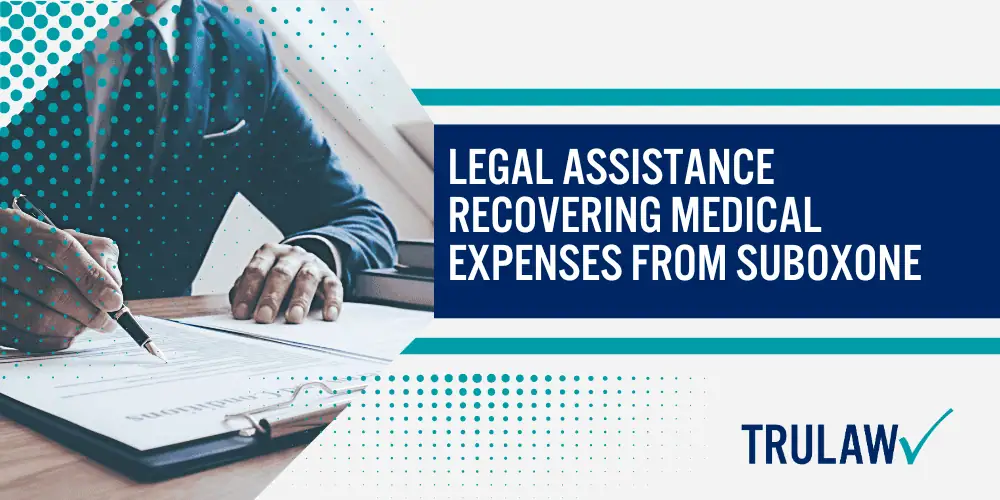
Individuals suffering from severe dental problems due to Suboxone treatment are demanding justice and compensation, backed by numerous adverse health reports.
Steps to File Your Suboxone Lawsuit With TruLaw Today
If you’re thinking of taking legal action for dental problems caused by Suboxone, you may qualify to file in the Suboxone Tooth Decay MDL.
Here’s a simplified breakdown of the steps to file a suboxone dental lawsuit:
- Initial Consultation: Engage with a law firm experienced in handling Suboxone claims and offers complimentary evaluations such as TruLaw.
- Document Collection: Gather all relevant medical records, dental treatment history, and communications regarding your prescription suboxone film. These documents serve as the foundation of your lawsuit.
- Filing the Lawsuit: Your legal team will draft and file a complaint against the manufacturers of Suboxone, outlining that you suffered tooth decay due to their negligence in warning about dental risks.
How Suboxone Lawyers at TruLaw Can Support Your Injury Case
Suboxone lawyers can be your strongest advocates throughout this challenging time.
We can provide you with decades of combined experience pursuing pharmaceutical litigation during the fight for the compensation you deserve.
You can contact TruLaw using the chat on this page to see if you qualify to file in the Suboxone Tooth Decay MDL.
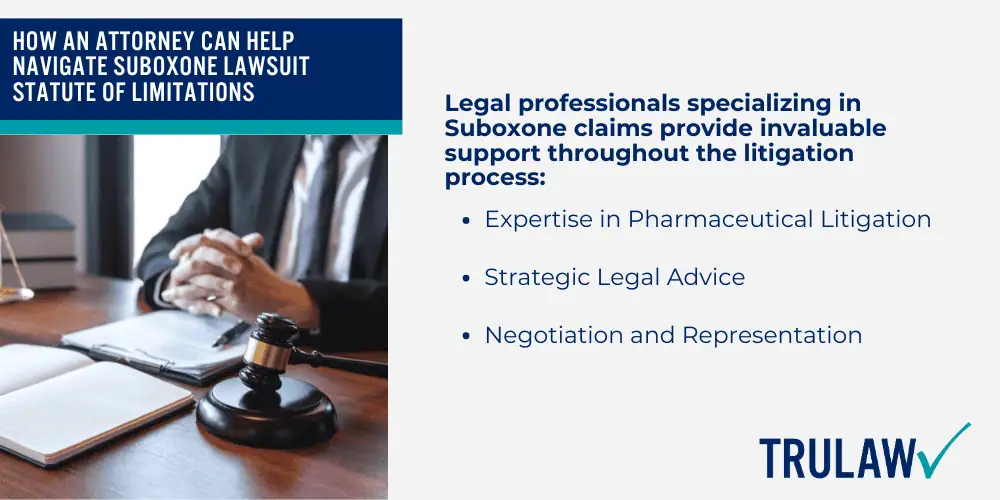
Legal professionals specializing in Suboxone claims provide invaluable support throughout the litigation process:
- Expertise in Pharmaceutical Litigation: Leveraging their in-depth knowledge of pharmaceutical law and precedent cases, attorneys navigate the complex legal landscape to advocate for your rights.
- Strategic Legal Advice: From evaluating the strength of your case to deciding on the best course of action, experienced suboxone tooth decay lawyers offer strategic guidance tailored to your specific situation.
- Negotiation and Representation: Whether negotiating suboxone settlement terms with the defendants or representing your interests in court, your legal team is committed to securing the best possible outcome for your case.
TruLaw advocates for a multidisciplinary approach to address the issues experienced by individuals dealing with Suboxone-related dental issues.
By providing legal support and advocating for comprehensive care, TruLaw aims to empower individuals on their path to recovery.
We’ll work to ensure you have access to the resources and support necessary to navigate both the physical and psychological hurdles of OUD treatment.
Suboxone Tooth Decay Multi-District Litigation 2025 Updates
The legal journey surrounding Suboxone’s alleged dental side effects has seen significant developments, evolving through various stages of litigation.
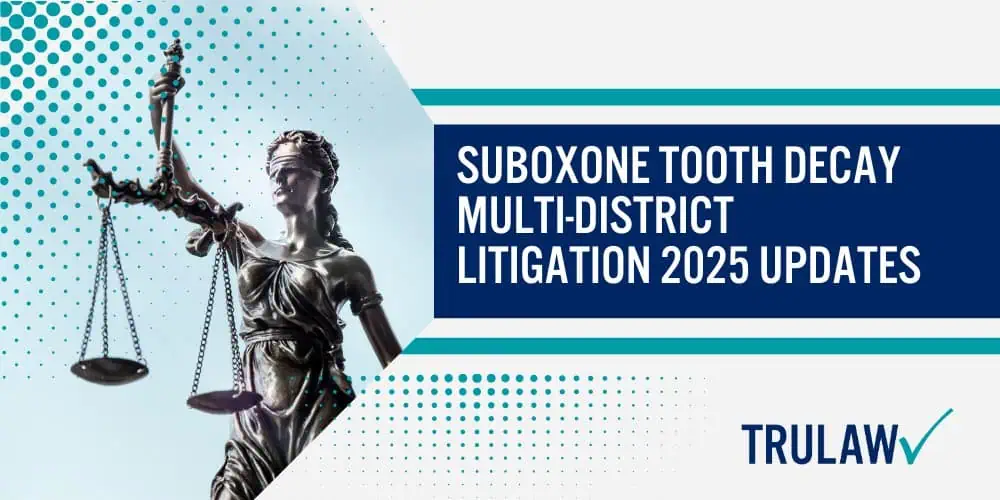
These updates serve as a beacon for individuals seeking recourse for their dental health issues purportedly linked to Suboxone use.
Latest Developments in the Suboxone Tooth Decay MDL
The panel on the Multidistrict Litigation (MDL) process has streamlined numerous Suboxone tooth decay lawsuits, aiming to handle pretrial proceedings efficiently.
Recent milestones of the suboxone multi-district litigation include:
- Consolidation into MDL: In a pivotal move, federal suboxone lawsuits across the United States were consolidated into an MDL, centralized in the Northern District of Ohio, to address common factual questions regarding Suboxone’s impact on dental health.
- Progress Towards Settlement Discussions: As the litigation advances, parties have begun to explore potential settlement frameworks, signaling a critical phase in the legal battle for compensation and accountability.
Key Dates in Suboxone Litigation History
Suboxone’s rise in popularity as an opioid addiction treatment coincided with growing concerns about its potential impact on dental health.
These concerns eventually ignited legal action.
The timeline of Suboxone litigation highlights key moments that have shaped the legal discourse surrounding the medication’s dental health implications:
- FDA Warning Issuance: The FDA’s announcement in January 2022, warning of the potential dental risks associated with Suboxone, marked a significant turning point, reinforcing the basis for legal actions.
- Initial Lawsuit Filings: The first suboxone teeth lawsuits were filed shortly after the FDA’s warning, with individuals coming forward to document their experiences of dental issues after Suboxone use.
- MDL Formation Date: The official formation of the MDL in the Northern District of Ohio provided a structured avenue for collectively addressing the claims, setting the stage for coordinated pretrial proceedings.
Comprehensive Dental Care Post-Suboxone
In the aftermath of experiencing dental issues due to Suboxone, it’s crucial to adopt a holistic approach to oral health recovery.
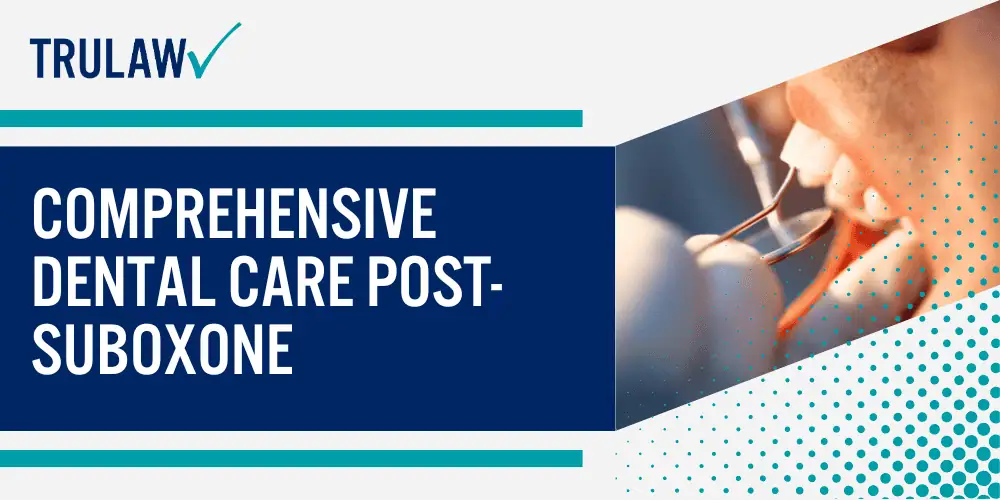
TruLaw emphasizes the importance of comprehensive dental care that extends beyond traditional hygiene practices, advocating for measures that support long-term dental wellness and mitigate further risks.
Beyond Oral Hygiene: Dental Care Tips
Suboxone treatment can affect oral health, so it’s important to take extra care of your teeth and gums.
This can be achieved through a combination of regular dental check-ups and specialized strategies designed to prevent dental issues from recurring.
Maintaining oral health post-Suboxone treatment involves routine care, such as:
- Regular Dental Check-ups: Routine visits to the dentist are fundamental, allowing for early detection and management of any emerging issues.
- pH-Balancing Rinses: Incorporate mouthwashes that balance oral pH to counteract the acidic effects of Suboxone, protecting enamel from erosion.
- Custom Dental Appliances: If bruxism (teeth grinding) is a concern, consider using protective night guards to prevent additional wear and tear on your teeth.
Alternative Therapies To Replace Suboxone For Opioid Use
The alternative therapies proposed for managing opioid dependence present a spectrum of innovative and less invasive options beyond conventional Suboxone strip treatment.
Alternative therapies present a more conducive route to recovery, emphasizing the preservation of dental well-being.
By integrating such alternative practices, patients can significantly reduce the risk of dental decay and other oral complications that may arise from the long-term use of Suboxone strips
The following supplementary dental care routines may enhance recovery and oral wellness:
- Oil Pulling: Swishing oil in the mouth to remove bacteria and promote gum health.
- High-Fluoride Treatments: Professional applications of fluoride can erode tooth enamel and help ward off decay.
- Dietary Adjustments: Incorporating foods high in calcium and vitamin D can support tooth and bone health while reducing sugary and acidic food intake helps prevent further enamel damage.
Are you struggling with dental issues caused by Suboxone?
TruLaw offers decades of combined experience litigating product liability claims in order to maximize your compensation in a settlement.
Connect with us for legal support and to discover how you can take control of your dental health and recovery journey.
Psychological Effects of Dental Health After Taking Suboxone
The process of recovering from opioid use disorder (OUD) with Suboxone introduces a unique set of significant physical and psychological challenges.
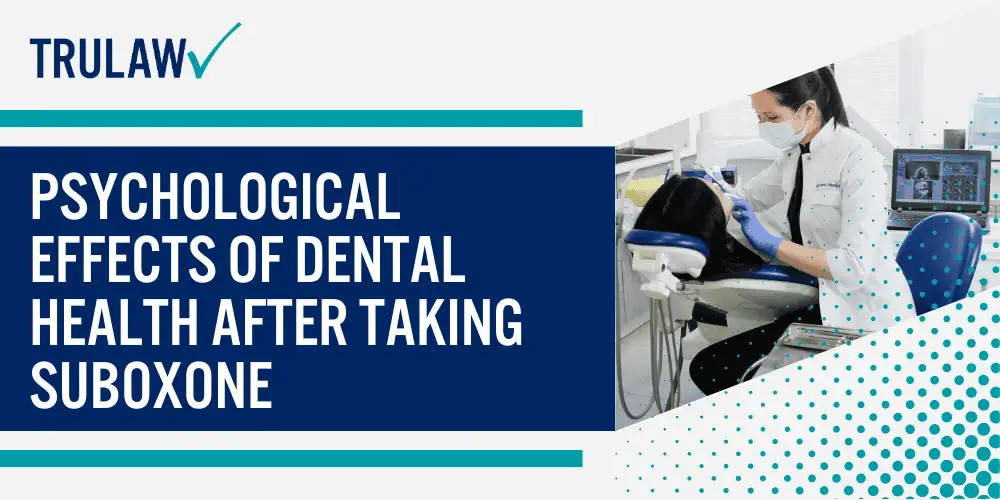
Recognizing and addressing the intertwined nature of dental health and mental well-being is necessary for a holistic approach to treatment and recovery.
Mental Health and Dental Well-being
Beyond the physical health impacts, Suboxone’s use is also linked to various psychological side effects, underscoring the complexity of its administration for opioid dependency treatment.
The psychological side effects of Suboxone may include, but are not limited to:
- Depression and Anxiety: Some patients report experiencing heightened feelings of depression and anxiety during their treatment with Suboxone, which can complicate recovery from opioid dependency.
- Mood Swings: The drug can cause significant mood swings, affecting the user’s emotional stability and overall quality of life.
- Sleep Disturbances: Insomnia and other sleep-related issues are common complaints among Suboxone users, potentially impacting their mental health and recovery progress.
The Suboxone Tooth Decay MDL and the broader concerns surrounding the drug’s use highlight the critical need for comprehensive patient care that addresses both the benefits and potential risks of treatment options for opioid dependency.
Addressing Anxiety from Dental Issues
Dental anxieties are often rooted in fear of pain, loss of control, or potential embarrassment.
Recognizing these anxieties is crucial to developing a treatment plan that addresses both the physical and mental aspects of dental health.
Proactive measures to mitigate anxiety and other psychological effects stemming from dental health issues include:
- Comprehensive Counseling: Supportive counseling can help individuals cope with the stress and anxiety related to dental health issues, offering strategies to manage emotional responses and improve mental well-being.
- Integrated Treatment Plans: Incorporating mental health support into treatment plans for those recovering from OUD and experiencing dental health issues ensures a more holistic approach to recovery and well-being.
- Patient Education: Informing patients about the potential psychological impacts of dental health issues and providing guidance on coping mechanisms can empower individuals to take active steps toward improving their mental and dental health.
Trusting TruLaw: #1 Suboxone Litigation Attorneys & Lawyers
TruLaw combines a deep commitment to justice with a proven track record in pharmaceutical litigation, positioning itself as a trusted ally for individuals facing health issues due to medications like Suboxone.
TruLaw’s expertise is not just in law; it’s in understanding the intricate relationship between pharmaceuticals and patient well-being.
Why Trust TruLaw: Expert Insight
Here’s why clients place their trust in us:
- Experienced Legal Team: Our attorneys specialize in Suboxone product liability lawsuits, bringing years of experience and a wealth of knowledge to every case.
- Comprehensive Case Analysis: We dive deep into the medical and legal aspects of each case, ensuring that no detail is overlooked in the pursuit of justice.
- Success in Settlements and Verdicts: TruLaw’s history of securing favorable outcomes for our clients speaks volumes about our capability and determination.
TruLaw’s Role in Patient Empowerment
At the heart of TruLaw’s mission is the empowerment of patients.
We can help you pursue justice in your personal injury claim through:
- Educating Clients: Providing clients with a clear understanding of their legal rights and the complexities of pharmaceutical litigation.
- Supporting Recovery: Beyond legal representation, we offer resources and guidance to help clients navigate their recovery journey.
- Advocating for Change: We pursue compensation for our clients through litigation and advocate for increased transparency and safety in the pharmaceutical industry.
If you or a loved one have experienced dental health issues after using suboxone sublingual strips, you may be eligible to file a claim to seek compensation.
Contact TruLaw using the chat on this page to find out if you qualify to file in the Suboxone Tooth Decay MDL today.
Suboxone Lawsuit Frequently Asked Questions
-
What are the alternative treatments to Suboxone sublingual strips?
Alternative treatments to Suboxone sublingual strips include methadone and naltrexone, which are FDA-approved for the treatment of Opioid Use Disorder (OUD) in an office-based setting.
Methadone acts as a full opioid agonist, while naltrexone is an opioid antagonist that blocks the effects of opioids.
-
What specific adverse events were observed at a higher rate in Suboxone users?
Adverse events observed at a higher rate in Suboxone users include nausea, headache, insomnia, and sweating.
These reports follow an alert of an increased risk of severe dental complications experienced by long-term patients using Suboxone to treat their opioid use disorder.
-
How does the duration of Suboxone usage impact the risk of dental issues?
The prolonged exposure of teeth to the acidic nature of Suboxone sublingual strips during dissolution under the tongue for absorption might lead to dental damage.
Additional dental issues commonly mentioned in reports are dry mouth and decreased saliva production.
-
Are there any preventive measures for patients using sublingual Suboxone strips?
To prevent dental issues, patients using Suboxone strips should maintain good oral hygiene, stay hydrated, and consider using sugar-free gum or lozenges to stimulate saliva production.
Consulting with a healthcare professional is essential if you are experiencing these complications.
-
What are the implications for healthcare providers prescribing Suboxone?
Healthcare providers prescribing sublingual buprenorphine-naloxone (Suboxone) should be aware of the potential for dental issues and monitor patients for oral health problems during treatment.
They should also provide guidance on oral hygiene and hydration.

Managing Attorney & Owner
With over 25 years of legal experience, Jessica Paluch-Hoerman is an Illinois lawyer, a CPA, and a mother of three. She spent the first decade of her career working as an international tax attorney at Deloitte.
In 2009, Jessie co-founded her own law firm with her husband – which has scaled to over 30 employees since its conception.
In 2016, Jessie founded TruLaw, which allows her to collaborate with attorneys and legal experts across the United States on a daily basis. This hypervaluable network of experts is what enables her to share the most reliable, accurate, and up-to-date legal information with our readers!
Additional Suboxone Lawsuit resources on our website:
Here, at TruLaw, we’re committed to helping victims get the justice they deserve.
Alongside our partner law firms, we have successfully collected over $3 Billion in verdicts and settlements on behalf of injured individuals.
Would you like our help?
At TruLaw, we fiercely combat corporations that endanger individuals’ well-being. If you’ve suffered injuries and believe these well-funded entities should be held accountable, we’re here for you.
With TruLaw, you gain access to successful and seasoned lawyers who maximize your chances of success. Our lawyers invest in you—they do not receive a dime until your lawsuit reaches a successful resolution!
AFFF Lawsuit claims are being filed against manufacturers of aqueous film-forming foam (AFFF), commonly used in firefighting.
Claims allege that companies such as 3M, DuPont, and Tyco Fire Products failed to adequately warn users about the potential dangers of AFFF exposure — including increased risks of various cancers and diseases.
Depo Provera Lawsuit claims are being filed by individuals who allege they developed meningioma (a type of brain tumor) after receiving Depo-Provera birth control injections.
A 2024 study found that women using Depo-Provera for at least 1 year are five times more likely to develop meningioma brain tumors compared to those not using the drug.
Suboxone Tooth Decay Lawsuit claims are being filed against Indivior, the manufacturer of Suboxone, a medication used to treat opioid addiction.
Claims allege that Indivior failed to adequately warn users about the potential dangers of severe tooth decay and dental injuries associated with Suboxone’s sublingual film version.
Social Media Harm Lawsuits are being filed against social media companies for allegedly causing mental health issues in children and teens.
Claims allege that companies like Meta, Google, ByteDance, and Snap designed addictive platforms that led to anxiety, depression, and other mental health issues without adequately warning users or parents.
Transvaginal Mesh Lawsuits are being filed against manufacturers of transvaginal mesh products used to treat pelvic organ prolapse (POP) and stress urinary incontinence (SUI).
Claims allege that companies like Ethicon, C.R. Bard, and Boston Scientific failed to adequately warn about potential dangers — including erosion, pain, and infection.
Bair Hugger Warming Blanket Lawsuits involve claims against 3M — alleging their surgical warming blankets caused severe infections and complications (particularly in hip and knee replacement surgeries).
Plaintiffs claim 3M failed to warn about potential risks — despite knowing about increased risk of deep joint infections since 2011.
Baby Formula NEC Lawsuit claims are being filed against manufacturers of cow’s milk-based baby formula products.
Claims allege that companies like Abbott Laboratories (Similac) and Mead Johnson & Company (Enfamil) failed to warn about the increased risk of necrotizing enterocolitis (NEC) in premature infants.
Here, at TruLaw, we’re committed to helping victims get the justice they deserve.
Alongside our partner law firms, we have successfully collected over $3 Billion in verdicts and settlements on behalf of injured individuals.
Would you like our help?
